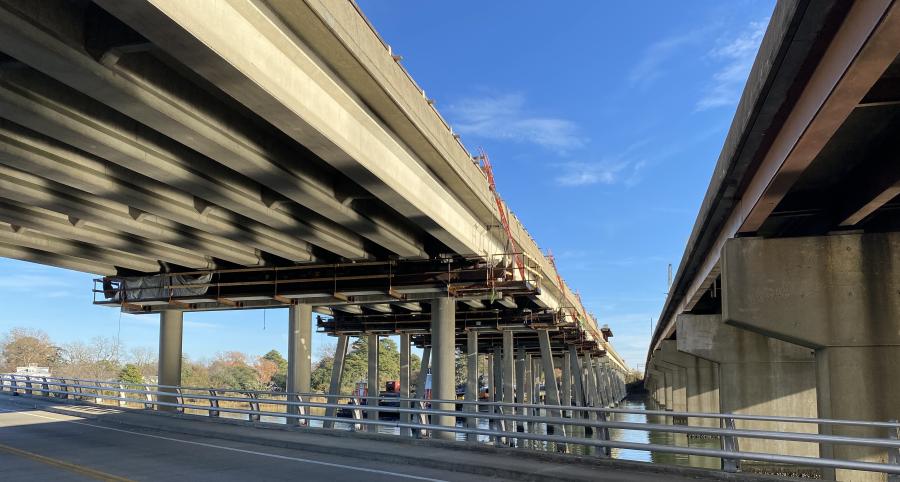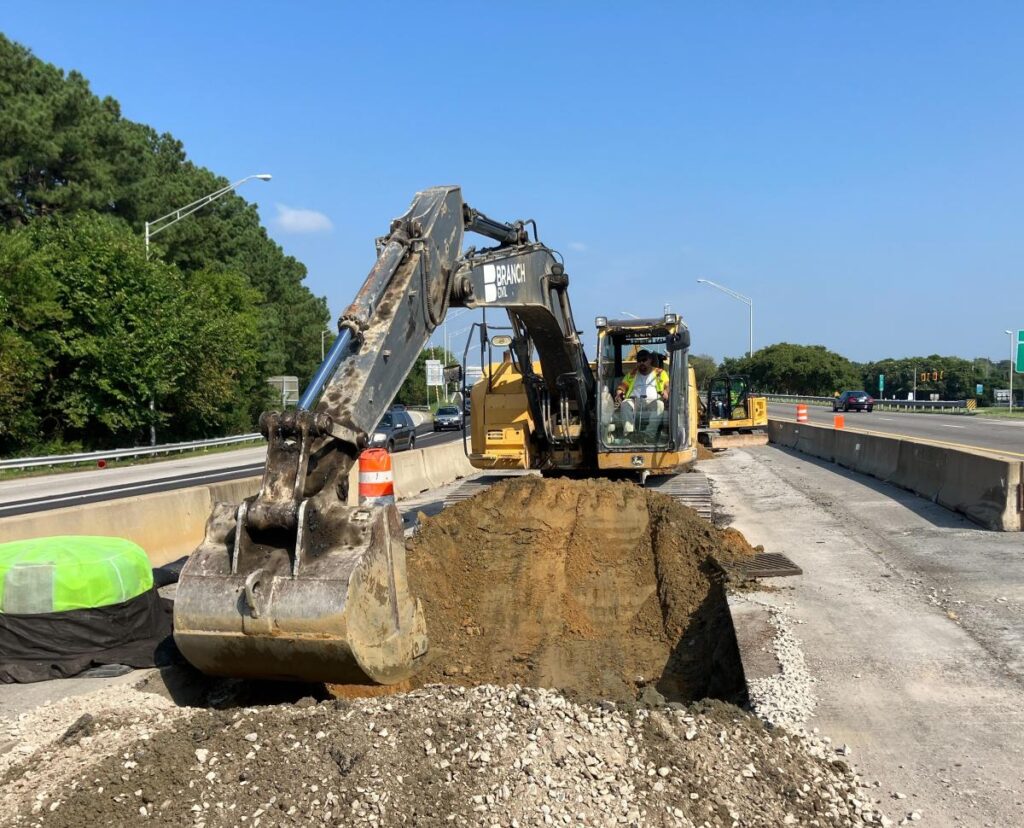Shirley-Branch Joint Venture team photo
Excavation for temporary drainage installation to facilitate future traffic shifts takes place in the median.
The cities of Hampton, Norfolk and Newport News in southeastern Virginia straddle interesting and, for motorists, challenging real estate. The region is home to some 1.8 million people and bristles with military bases, universities, companies, retail locations and homes. Major rivers, including the James, Nansemond and Elizabeth, feed into the Chesapeake Bay and ultimately, the nearby Atlantic Ocean.
Motorists who navigate this complicated region often travel on bridges and bridge-tunnels over major bodies of water. Transportation experts believe there are only two other places like this in the world.

Shirley-Branch Joint Venture team photo
The Virginia Department of Transportation (VDOT) designed the Hampton Roads Express Lanes (HREL) network to transport more motorists through the region while helping to alleviate congestion and providing motorists more travel options. This continuous 45-mi. network of Express Lanes in each traffic direction on I-64, from east of Denbigh Boulevard in Newport News to the I-64/I-264/I-664 Bowers Hill Interchange in Chesapeake, is in various stages of construction and design. Construction is under way in the HREL Hampton Segment and is scheduled to be completed as early as late 2026.
Virginia construction companies Shirley Contracting Company LLC and Branch Civil have teamed together as the Shirley-Branch Joint Venture (SBJV) to build this section of the project. The job will cost $314 million and a U.S. Department of Transportation loan to VDOT will help fund the Hampton Segment.
Work on the Hampton Segment includes:
- Converting three current east- and westbound lanes on I-64 into one Express Lane, one part-time Express Lane and two general purpose lanes in each direction;
- Widening I-64, repaving the existing lanes and adding a 12-ft.-wide travel lane in each direction for a total of 2 mi.;
- Replacing two eastbound bridges over the Hampton River and widening and rehabilitating the westbound Hampton River bridge; and
- Building overhead signage, noise barriers and a tolling gantry.
The Hampton Segment will fit together with four other segments, including the $3.9 billion Hampton Roads Bridge-Tunnel Expansion project, where additional joint venture partners will work to widen nearly 10 miles of I-64 in Norfolk and Hampton and build twin tunnels under the Hampton Roads harbor.
This Hampton project corridor of I-64 currently carries more than 103,000 vehicles per day.
This project will require the use of dozers, excavators, cranes and pavers to handle an impressive amount of material. The current plans estimate the following needs: 90,000 tons of asphalt, 25,000 cu. yds. of concrete and 30,000 tons of dirt.
Joseph Ludwig has been overseeing the Hampton Segment for VDOT, while Rick Meyer of SBJV is the construction manager for the project.
Design-Build Project
“The work is a design-build project, which means the design and construction overlap and run concurrently,” said Ludwig of VDOT. “The roadway and bridge design are nearly complete, and construction began ramping up in the summer of 2023. From a time standpoint, the project is about 30 percent complete.”
Inevitably, major projects face environmental hurdles and the HREL Hampton Segment project has been no exception.
“Working on a bridge over a navigable waterway means we have to get U.S. Coast Guard approval, which requires the constructed bridge to meet certain design and navigational standards,” said Ludwig.
Shirley-Branch Joint Venture team photo
Project planners decided to install temporary Intelligent Transportation Systems (ITS) and lighting lines above ground on temporary wooden poles alongside the new roadway. This will make it easier for construction workers to navigate the construction zone without impacting the existing ITS and lighting systems that need to be maintained during construction.
The stormwater drainage system will travel underneath I-64. Workers are using a jack and bore system to push the pipes underneath the freeway. Because of heavy traffic in this corridor, planners decided that an open-cut trench, though easier, would not be possible.
The SBJV team is utilizing pits that are 40-ft. long and 12-ft. deep to push 20-ft. sections of steel casing pipe underneath the interstate. The team will then insert a concrete pipe inside the steel casing and use grout to seal the area between the concrete pipe and steel casing. This strategy will reduce impacts to traffic and allow other work to go on unimpeded.
The construction team is working in the median to prepare for the later part of the project. The next traffic shift will happen in late spring 2024. Most of the work being done now is on the outside lanes.
Highway construction and heavy traffic almost always means a steady hum of loud noise and the project has made plans to install sound barriers to muffle traffic noise.
“In some areas of the project, the SBJV team will be constructing 15- to 20-foot-tall noise barriers along the corridor,” said Meyer. “We’ll be drilling and setting caissons, utilizing steel rebar and concrete, and then installing concrete posts on top of the caissons. The precast noise barrier panels will be delivered in 24-foot-wide sections and then set between the concrete posts.”
On the bridges, the construction team will be using transparent acrylic sound walls in several places. Not only will these acrylic walls be much lighter than the concrete version, but they also will have the aesthetic effect of allowing motorists to enjoy the scenic river views.
Shirley-Branch Joint Venture team photo
McLean Contracting Company, a major subcontractor on the project, will be performing some heavy lifting on the I-64 bridge repair. The firm will be responsible for jacking up the bridge beams and replacing bridge bearings. This work is important for the long-term functioning of the bridges.
The construction team also is also responsible for important safety features, such as the ITS. This safety package involves lighting and microwave towers for vehicle detectors. CCTV cameras and dynamic message signage help ensure motorists can safely transition from the general purpose lanes to the Express Lanes.
“We hope this project will be a game changer,” said Ludwig. “We have several projects synchronized to be completed around the same time. It will change how people are able to move through the Hampton Roads region. This is a win-win for the public and should enable motorists to save many hours in a year.” CEG
Virginia Department of Transportation map
Read the full article here

